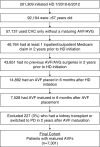Long-Term Outcomes of Arteriovenous Fistulas with Unassisted versus Assisted Maturation: A Retrospective National Hemodialysis Cohort Study
- PMID: 31611240
- PMCID: PMC6830790
- DOI: 10.1681/ASN.2019030318
Long-Term Outcomes of Arteriovenous Fistulas with Unassisted versus Assisted Maturation: A Retrospective National Hemodialysis Cohort Study
Abstract
Background: About half of arteriovenous fistulas (AVFs) require one or more interventions before successful dialysis use, a process called assisted maturation. Previous research suggested that AVF abandonment and interventions to maintain patency after maturation may be more frequent with assisted maturation versus unassisted maturation.
Methods: Using the US Renal Data System, we retrospectively compared patients with assisted versus unassisted AVF maturation for postmaturation AVF outcomes, including functional primary patency loss (requiring intervention after achieving AVF maturation), AVF abandonment, and frequency of interventions.
Results: We included 7301 patients ≥67 years who initiated hemodialysis from July 2010 to June 2012 with a catheter and no prior AVF; all had an AVF created within 6 months of starting hemodialysis and used for dialysis (matured) within 6 months of creation, with 2-year postmaturation follow-up. AVFs matured without prior intervention for 56% of the patients. Assisted AVF maturation with one, two, three, or four or more prematuration interventions occurred in 23%, 12%, 5%, and 4% of patients, respectively. Patients with prematuration interventions had significantly increased risk of functional primary patency loss compared with patients who had unassisted AVF maturation, and the risk increased with the number of interventions. Although the likelihood of AVF abandonment was not higher among patients with up to three prematuration interventions compared with patients with unassisted AVF maturation, it was significantly higher among those with four or more interventions.
Conclusions: For this cohort of patients undergoing assisted AVF maturation, we observed a positive association between the number of prematuration AVF interventions and the likelihood of functional primary patency loss and frequency of postmaturation interventions.
Keywords: arteriovenous access; arteriovenous fistula; vascular access.
Copyright © 2019 by the American Society of Nephrology.
Figures





Comment in
-
Fistula Interventions: Less Is More.J Am Soc Nephrol. 2019 Nov;30(11):2040-2042. doi: 10.1681/ASN.2019090952. Epub 2019 Oct 14. J Am Soc Nephrol. 2019. PMID: 31611241 Free PMC article. No abstract available.
References
-
- Fistula first catheter last initiative. Available at: http://esrdncc.org/ffcl/. Accessed April 30, 2018
-
- Vascular Access 2006 Work Group : Clinical practice guidelines for vascular access. Am J Kidney Dis 48: S176–S247, 2006 - PubMed
-
- Allon M: Current management of vascular access. Clin J Am Soc Nephrol 2: 786–800, 2007 - PubMed
-
- Allon M, Imrey PB, Cheung AK, Radeva M, Alpers CE, Beck GJ, et al. . Hemodialysis Fistula Maturation (HFM) Study Group : Relationships between clinical processes and arteriovenous fistula cannulation and maturation: A Multicenter prospective cohort study. Am J Kidney Dis 71: 677–689, 2018 - PMC - PubMed
Publication types
MeSH terms
Grants and funding
LinkOut - more resources
Full Text Sources
Medical

